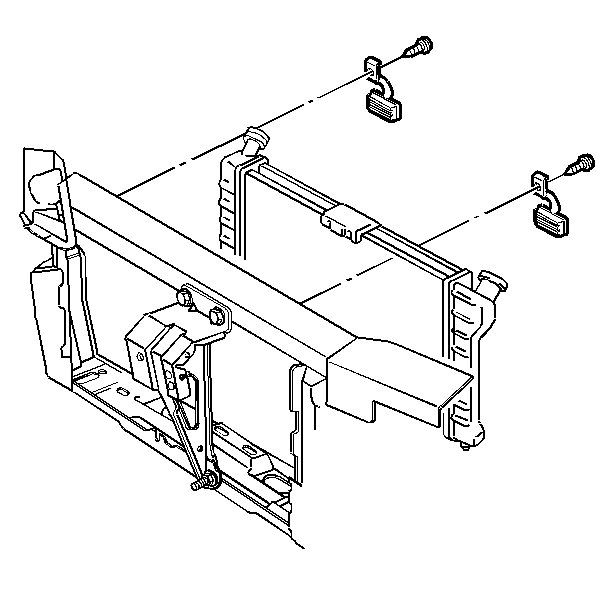Removal Procedure
When you replace the radiator, transfer all of the fittings.
- Disconnect the negative battery cable. Refer to
Caution: Unless directed otherwise, the ignition and start switch must be in the OFF or LOCK position, and all electrical loads must be OFF before servicing any electrical component. Disconnect the negative battery cable to prevent an electrical spark should a tool or equipment come in contact with an exposed electrical terminal. Failure to follow these precautions may result in personal injury and/or damage to the vehicle or its components.
in General Information. - Remove the air cleaner and duct assembly.
- Drain the coolant. Refer to Cooling System Draining and Filling .
- Remove the bolts of the engine mount strut bracket from the upper tie bar. Rotate the struts and the brackets rearward. Refer to Engine Mount Bracket Replacement in Engine Mechanical.
- Remove the radiator upper bracket screws and the brackets from the upper radiator mounting panel.
- Disconnect the electrical connectors from the cooling fans. Remove the cooling fan mounting bolts and the fans.Refer to Electric Cooling Fan .
- Disconnect the radiator inlet hose and the outlet hose and clamps from the radiator.
- Disconnect the radiator overflow hose from the radiator filler neck.
- Disconnect the electrical connector from the coolant level indicator module. Remove the module. Refer to Coolant Level Indicator Module Replacement .
- Disconnect the transaxle upper and lower oil cooler lines from the radiator.
- Lift the radiator up and out from the vehicle.
Notice: When adding coolant, use DEX-COOL® coolant. If silicated coolant is added to the system, premature engine, heater core or radiator corrosion may result. In addition, the engine coolant will require change sooner-at 50 000 km (30,000 mi) or 24 months.
Important: In order to prevent shearing of the rubber bushings, loosen the bolts on the engine mount struts before swinging the struts.


Installation Procedure
- Install the radiator to the lower mounts.
- Connect the transaxle upper and lower oil cooler lines to the radiator.
- Install the coolant level indicator module to the radiator. Connect the module electrical connector. Refer to Coolant Level Indicator Module Replacement .
- Connect the radiator inlet hose and the outlet hose and the clamps to the radiator.
- Connect the radiator overflow hose to the radiator filler neck.
- Install the upper radiator brackets and the screws.
- Install the fans and the fan mounting bolts to the radiator. Connect the electrical connectors to the fans.
- Properly position the engine mount struts. Refer to Engine Mount Strut Replacement in Engine Mechanical
- Refill the coolant. Refer to Cooling System Draining and Filling .
- Install the air cleaner and duct assembly.
- Connect the negative battery cable.
- Start the engine. After the engine reaches normal operating temperature, check for coolant leaks.


Tighten
Tighten the screws to 10 N·m (89 lb in).
Notice: Use the correct fastener in the correct location. Replacement fasteners must be the correct part number for that application. Fasteners requiring replacement or fasteners requiring the use of thread locking compound or sealant are identified in the service procedure. Do not use paints, lubricants, or corrosion inhibitors on fasteners or fastener joint surfaces unless specified. These coatings affect fastener torque and joint clamping force and may damage the fastener. Use the correct tightening sequence and specifications when installing fasteners in order to avoid damage to parts and systems.
Tighten
Tighten the bolts to 6 N·m (53 lb in). Refer
to
Electric Cooling Fan
.
Tighten
Tighten the negative battery cable bolt to 15 N·m (11 lb ft).
